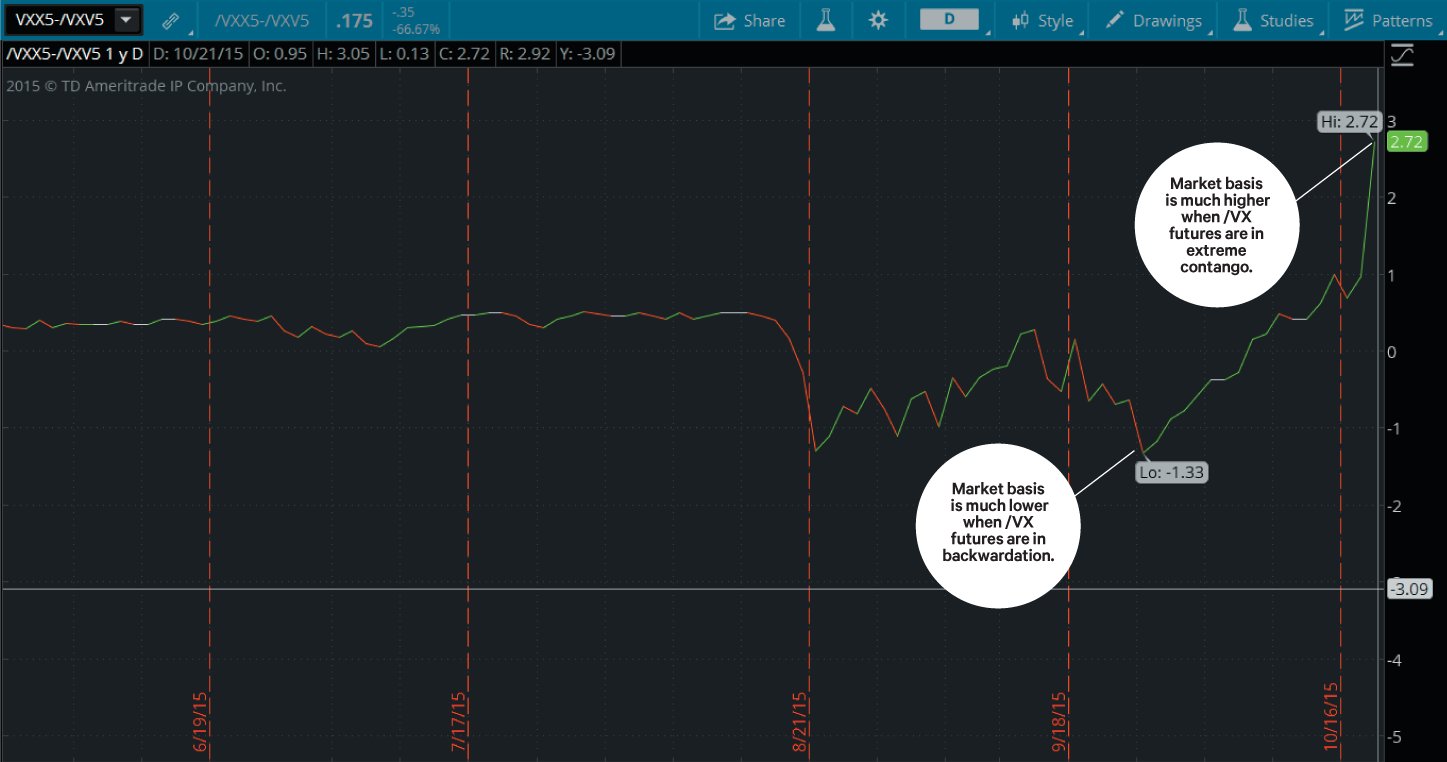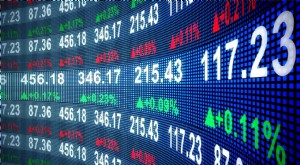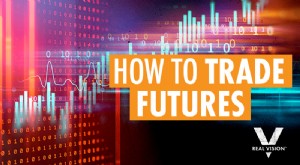Cara Berdagang Berjangka Dalam 3-D:Perdagangan Dasar
Futures bisa menjadi cara yang mudah dan hemat modal untuk berspekulasi atau melakukan lindung nilai. Anda pikir harga jagung akan lebih tinggi? Membeli kontrak berjangka jagung /ZC adalah cara yang lebih mudah untuk memasang taruhan daripada membeli ladang jagung dan menanamnya sendiri. Bagaimana dengan lindung nilai jangka pendek pada portofolio saham S&P 500 yang besar, tepat sebelum pengumuman Fed? /ES S&P 500 futures sesuai dengan tagihan itu. Sama seperti saham, berjangka bisa berupa perdagangan jangka panjang atau scalping cepat. Namun berbeda dengan saham, berjangka juga dapat menawarkan peluang perdagangan yang berbeda karena basisnya, yang hanya diketahui oleh sedikit pedagang individu pemula.
Dasar 101
"Basis" adalah istilah untuk perbedaan harga berjangka dalam berbagai kadaluarsa, atau harga tunai (“spot”) dari produk pokok dan harga berjangka. Harga berjangka di berbagai masa berlaku berbeda satu sama lain dan harga spot karena biaya carry, dan dampak penawaran dan permintaan. Perbedaan itu mewakili dasarnya. /ES berjangka, Misalnya, memiliki kontrak yang berakhir pada bulan Maret, Juni, September, dan Desember. / ZC jagung berjangka memiliki kontrak yang berakhir pada bulan Maret, Mungkin, Juli, September, dan Desember. /ZB obligasi, /GC emas dan, /CL minyak mentah berjangka memiliki set kedaluwarsanya sendiri.
Dasar Perdagangan
Dalam sebuah kata, perdagangan dasar adalah membeli masa depan dalam satu bulan kedaluwarsa, dan menjualnya di bulan kedaluwarsa yang berbeda—seperti menjual /ES Maret dan membeli /ES Juni. Ini seperti perdagangan pasangan antarpasar, tetapi dengan korelasi mendekati 100%. Anda berspekulasi atas dasar peningkatan dan pelebaran, atau mengecil dan menyempit. Karena dua futures didasarkan pada dasar yang sama (misalnya S&P 500, obligasi Treasury, minyak mentah, dll.), mereka sangat berkorelasi. Mereka cenderung bergerak naik dan turun secara bersamaan. Tetapi ketika mereka tidak bergerak pada saat yang sama, atau dengan jumlah yang sama, dasar berubah.
Karena dasarnya bisa negatif, di mana harga masa depan kedaluwarsa lebih lanjut lebih rendah dari harga masa depan kedaluwarsa yang lebih dekat (juga dikenal sebagai "mundur"), penting untuk mengetahui ke arah mana Anda berpikir masa depan jangka pendek akan bergerak, relatif terhadap masa depan bulan-belakang. Beberapa futures seperti /ES secara teratur mundur, sehingga basis pelebaran berarti menjadi lebih negatif. Jika Anda pikir itu akan melebar, Anda mungkin mempertimbangkan untuk membeli masa depan jangka pendek dan mempersingkat masa depan bulan belakang (mis., Anda akan membeli Maret / ES dan Juni pendek / ES).
Ketika harga futures masa kadaluarsa lebih lanjut lebih tinggi dari masa kadaluarsa yang lebih dekat, itu disebut "contango." Di contango, dasarnya adalah positif. Jika /CL futures berada di contango, dan Anda pikir dasarnya akan melebar, Anda mungkin mempertimbangkan untuk mempersingkat masa depan /CL dalam waktu dekat, dan membeli bulan belakang / CL masa depan.
4 Langkah Untuk Mendapatkan Dasar
Untuk dasar perdagangan, Anda harus melihat dasarnya. Dengan itu, pemikir ® telah Anda tutupi.
1. Pada tab Trade of thinkorswim ® , Anda dapat melihat masa berlaku kontrak berjangka yang tersedia dengan mengetikkan simbol root (mis. /ES) dan memilih “Semua” dari menu tarik-turun.
2. Untuk melihat harga dasar antara kedaluwarsa berjangka berturut-turut, klik menu tarik-turun "Sebarkan" dan pilih "Kalender."
3. Klik panah di sebelah salah satu kontrak berjangka untuk memperluas harga dasar, yang merupakan kedaluwarsa lebih lanjut (atau mundur), dikurangi kadaluarsa yang lebih dekat.
4. Dari harga dasar yang baru saja Anda buka, Anda dapat membuat bagan dasar dengan mengklik kanan "=" sebelum simbol berjangka, dan mengikuti jalur klik “Info selengkapnya…”>TOS Charts>kotak kiri atas di menu kisi grafik.
FIGURE 1: Source:thinkorswim by TD Ameritrade. Untuk tujuan ilustrasi saja.
Basis Trading In the Real World
You may consider the futures basis because they can be traded by themselves, kind of like stocks pairs trades. Sebagai contoh, maybe you don’t have a bullish or bearish bias on the futures’ underlying product itself. But considering the futures basis, you think it might move higher or lower.
Trading the futures basis also has potential advantages over stock pairs trading. Pertama, the contract and tick size are the same for a given future. You don't need to adjust the quantities of the trade to account for different contract specification. Kedua, the margin requirement for the basis trades can be lower than for a single long or short future because the basis trade is simultaneously long and short futures. The basis tends to have smaller price changes than the individual future would. So the margin requirement is also smaller.
Let’s look at three futures basis trading scenarios.
Crude Oil (/CL)
Crude oil futures contracts typically go out a couple of years. They’re one of the most liquid, actively traded futures contracts, and the basis can move around a lot. To understand why, think about how crude oil gets turned into gasoline and other “stuff.” It gets pumped out of the ground and transported to a refinery, and that costs money. If the oil is stored, there are insurance and storage fees, as well as interest charges if you’re borrowing money to buy it.
All those things go into the basis of /CL futures, and would make the further-term futures more expensive than near-term futures because those costs are built into the futures’ prices. But with the futures basis, there’s also the expectation of over- or under-supply in the coming months and years. You can see that when you look at /CL futures prices. Backwardation in /CL can happen when the market sees a shortage in crude oil, and where near-term demand outstrips immediate supply. The price of the near expiration /CL future is pushed higher than the back month. But /CL is more often in “contango, ” where the carry costs make the back months slightly higher than the near months, and there is Backwardation in /CL can happen when the market sees a shortage in crude oil, and where near-term demand outstrips immediate supply. The price of the near expiration /CL future is pushed higher than the back month. But /CL is more often in “contango, ” where the carry costs make the back months slightly higher than the near months, and there is equilibrium between supply and demand. If you see /CL in backwardation and you think the causes are temporary, and that /CL will move back to contango, you could consider shorting the near-expiration /CL and buy the further-expiration /CL. The risk, tentu saja, is that /CL could move further in backwardation, resulting in a loss on the trade. And there’s never a guarantee that contango has to happen in the future. But the trade could be profitable if the futures move back to contango before the expiration of the near-term future.
S&P 500 Index (/ES)
One of the most widely watched and actively traded futures is the /ES contract based on the S&P 500 stock index. /ES trades until 3:15 p.m. CT during “regular” market hours. The price of /ES is based on the value of the stocks in the S&P 500 (which is the SPX index), and the cost to carry the portfolio of those stocks. There is an interest charge to borrow money to buy shares. The interest is offset by dividends that are paid by the S&P 500 stocks.
The net impact of interest and dividends determines the basis between the / ES and the SPX. Nowadays with interest rates low relative to dividends, /ES futures are usually in backwardation, and the basis doesn’t fluctuate much. But because S&P 500 stocks stop trading at 3:00 p.m. CT, jadi, juga, does the price of the SPX stop updating. And in the 15 minutes between 3:00 p.m. and 3:15 p.m., when the /ES continues to trade, it can move higher or lower than what the basis calculation would suggest based on news that arrives after 3:00 p.m., or on the opening of large positions in /ES in the last 15 minutes of trading that anticipate the next day’s price movement.
If the /ES to SPX basis is $-10, when the /ES moves up relative to where SPX closed and makes the basis $-8, Misalnya, that can signal a stronger open the next day. If / ES moves down relative to the SPX closing price to make the basis $-12, that can signal a weaker open the next day. Looking at the /ES to SPX basis before and after 3:00 pm can give you a clue as to the next day’s opening price action. This may impact stop orders, and even technical indicators you might be tracking.
CBOE Volatility Index (/VX)
Volatility futures might be the trickiest to understand. But they might offer the most interesting opportunities. The CBOE Volatility Index (VIX) is derived from the out-of-the-money SPX option prices. When traders anticipate larger price changes in the SPX (i.e. more volatility), the out-of-the-money SPX option prices can increase in price. That, pada gilirannya, pushes up the VIX. When traders anticipate smaller price changes in the SPX (i.e., lower volatility), the out-of-the-money SPX prices can drop, which in turn drives the VIX lower.
You can’t trade the VIX directly, and /VX futures are a way to speculate on the direction of volatility. But /VX futures are only modestly tied to the VIX. “Modestly” because /VX settles to the VIX settlement value at their expiration. But there isn’t any cost of carry between the VIX and /VX futures be- cause you can’t buy the VIX like you can buy crude oil or a stock portfolio. That makes /VX futures pure indications of how much future volatility the market anticipates. The basis you see between the near and further month in /VX futures reflects whether the market sees more volatility near term or longer term.
Most of the time /VX futures are in contango—where the market expects more volatility the further into the future you look. But when the market panics and drops, generally the VIX rallies the most, the closest expiration /VX future rallies a bit less, and further expiration /VX futures rally a little less than those. That can push /VX futures into backwardation, and make the basis negative.
Figure 2 charts just this scenario, when a market dropped and pushed volatility higher, and the /VX basis became negative.

FIGURE 2:NEGATIVE BASIS
To view basis on /VX, you have to enter it manually as a pair (i.e., longer-term future minus shorter-term future, or /VXX5-/VXV5 as shown above). Most of the time, /VX futures are in contango, as was the case prior to August in the chart. Source:thinkorswim by TD Ameritrade. Untuk tujuan ilustrasi saja.
Most of the time, the price of the back-month /VX future is higher than the price of the near-month /VX future, and the basis is positive. When the market became more volatile, the basis became negative. If you believe the market will calm down, and the front-month /VX will drop relative to the back month, and the basis will go from negative to positive, you could consider shorting the front-month /VX future and buy the backmonth /VX future. That trade could be profitable if the basis goes from negative to positive. But the trade would lose money if the basis became more negative—which is something that happened in the 2008 market crisis.
At the closing bell, /VX basis trading isn’t for the faint of heart. If you’re already a proficient futures trader, consider this another tool in the strategy toolbox. But even if you’re not ready to trade it, /VX basis can certainly offer you clues as to how the market is forecasting volatility.
Open a Futures Account
For qualified accounts, you’ll need Level 3 options approval to trade futures. Log in to your account at tdameritrade.com. Under the Trade tab, go to Futures &Forex for more information.
Perdagangan berjangka
-
 Bagaimana cara berdagang saham
Bagaimana cara berdagang saham Perdagangan saham mungkin terdengar glamor, tetapi di balik layar itu sebenarnya banyak kerja keras dan dapat melibatkan penelitian ekstensif. Meskipun tidak selalu mudah, investor baru dapat mengambi...
-
 Cara Memulai Perdagangan Berjangka
Cara Memulai Perdagangan Berjangka Oleh:Wayne Duggan Untuk pedagang baru, kontrak berjangka mungkin tampak seperti pasar yang rumit yang hanya diperuntukkan bagi pedagang berpengalaman. Tapi berjangka sama seperti instrumen perdag...


